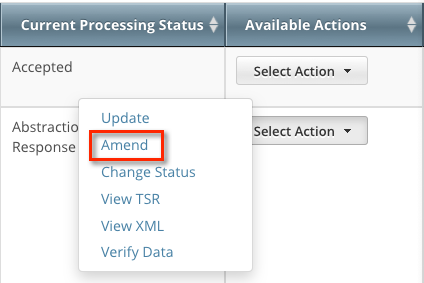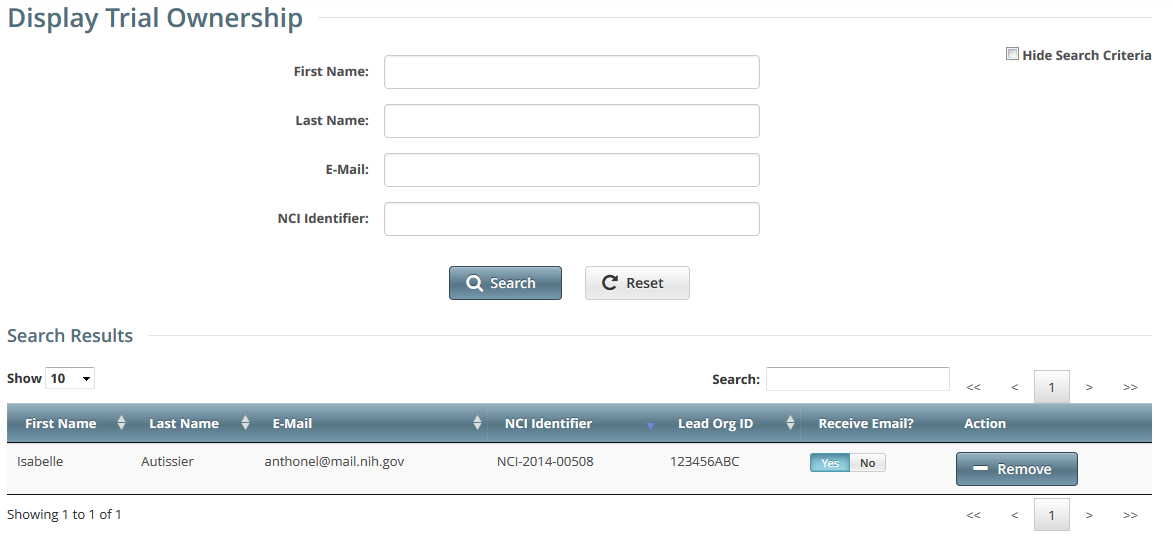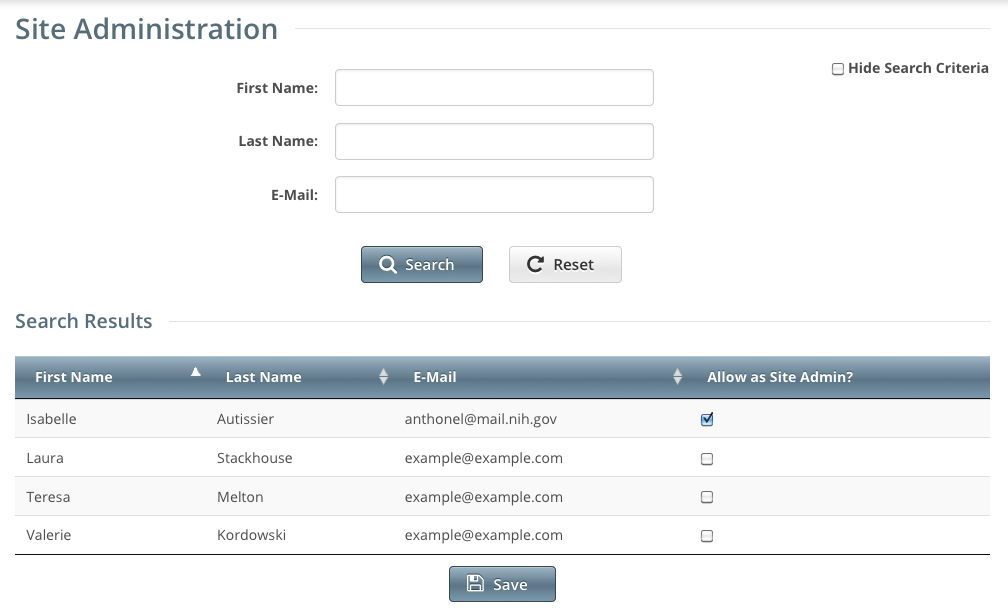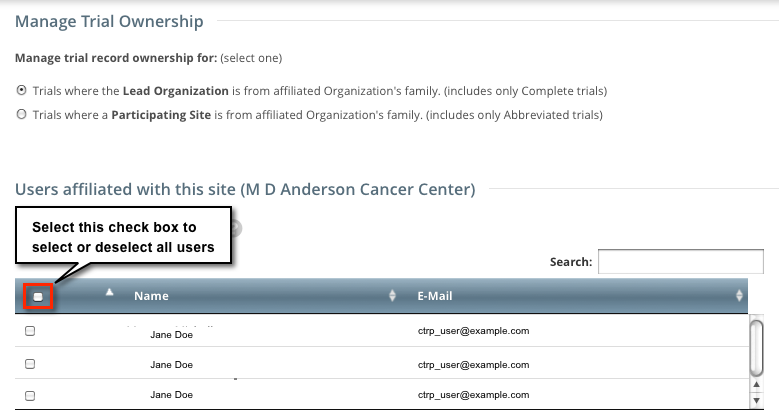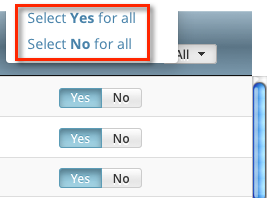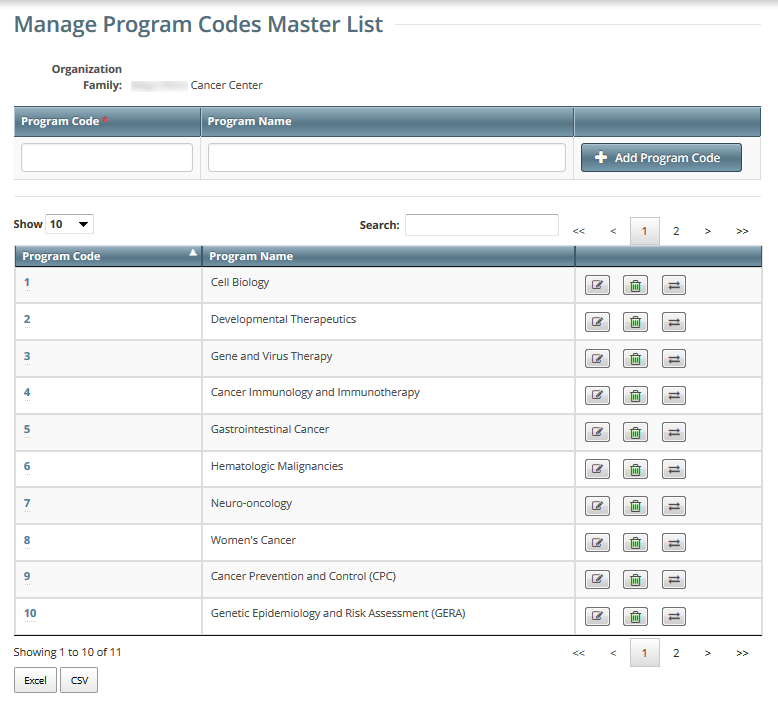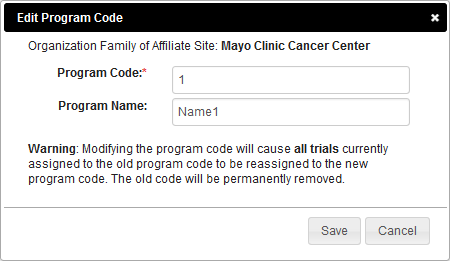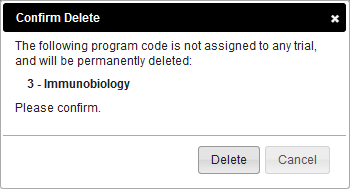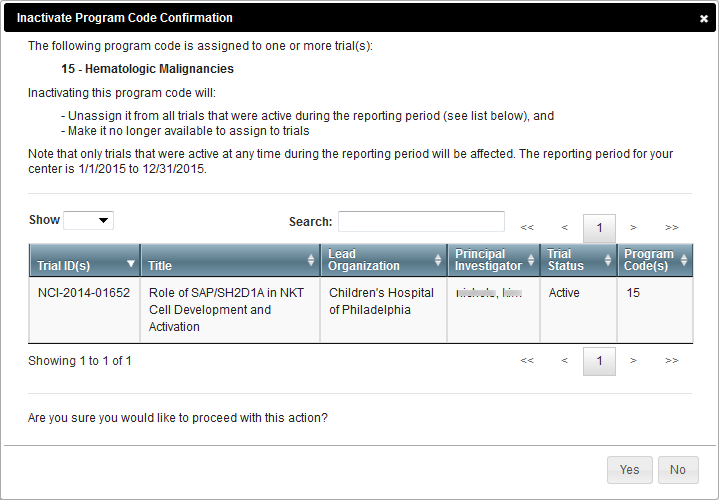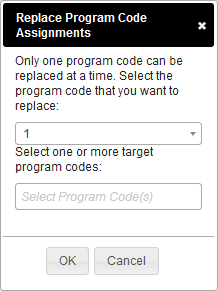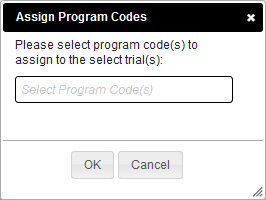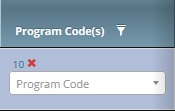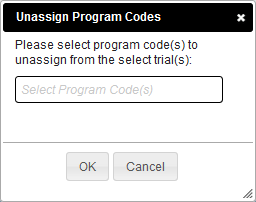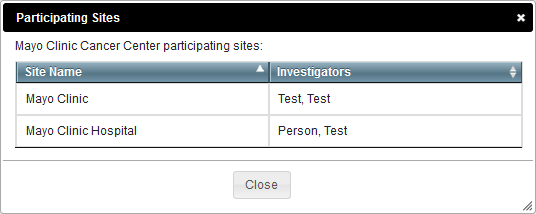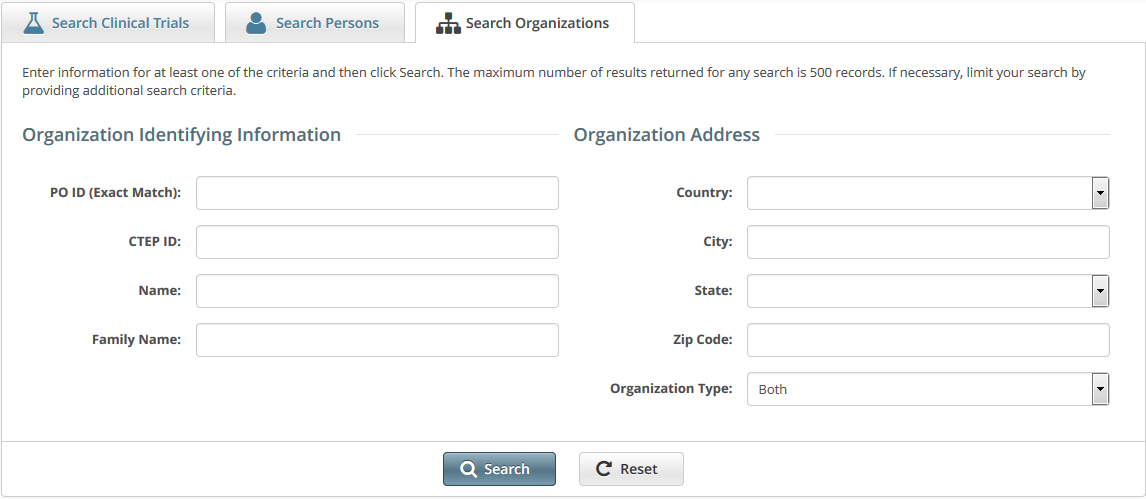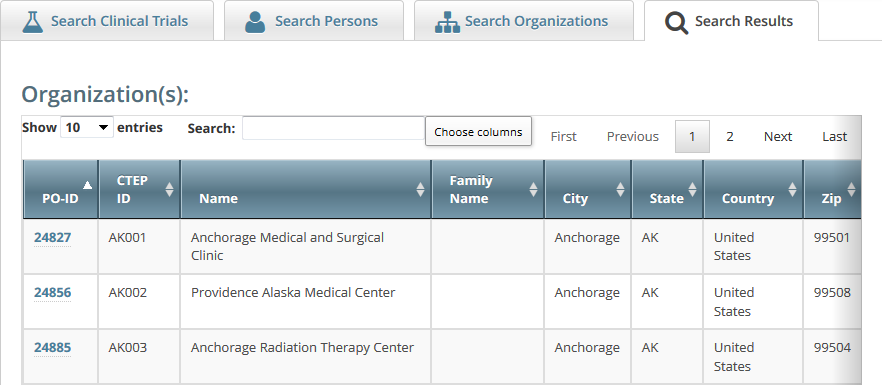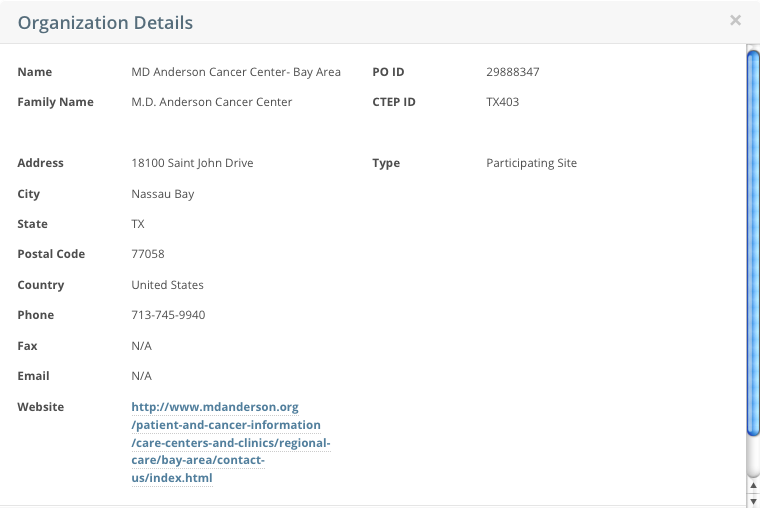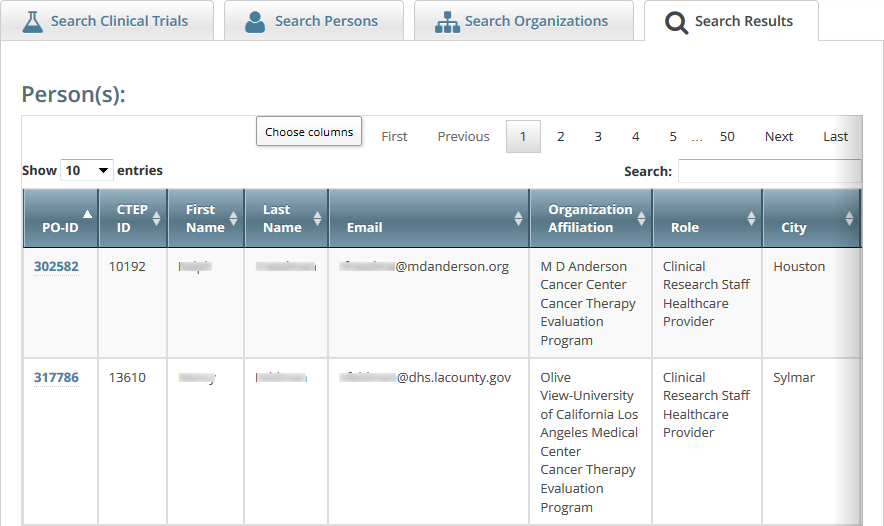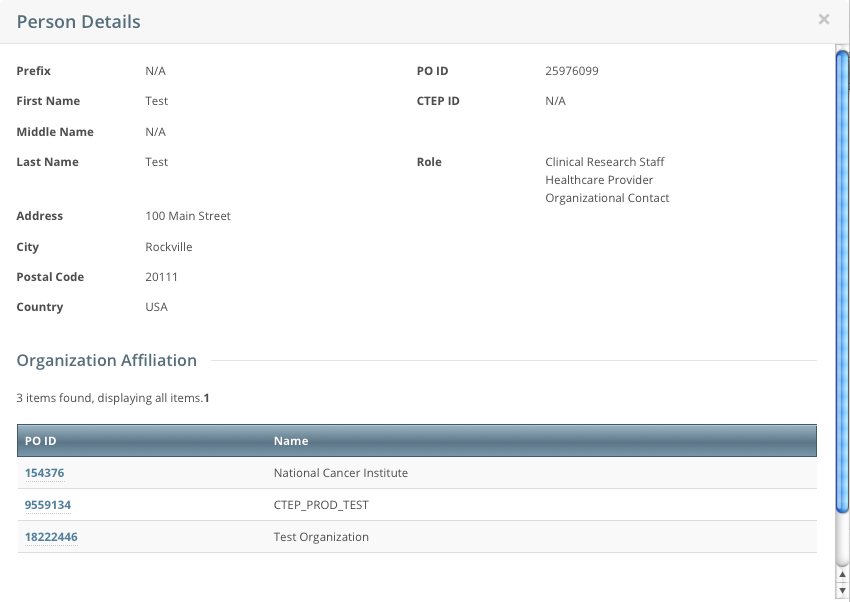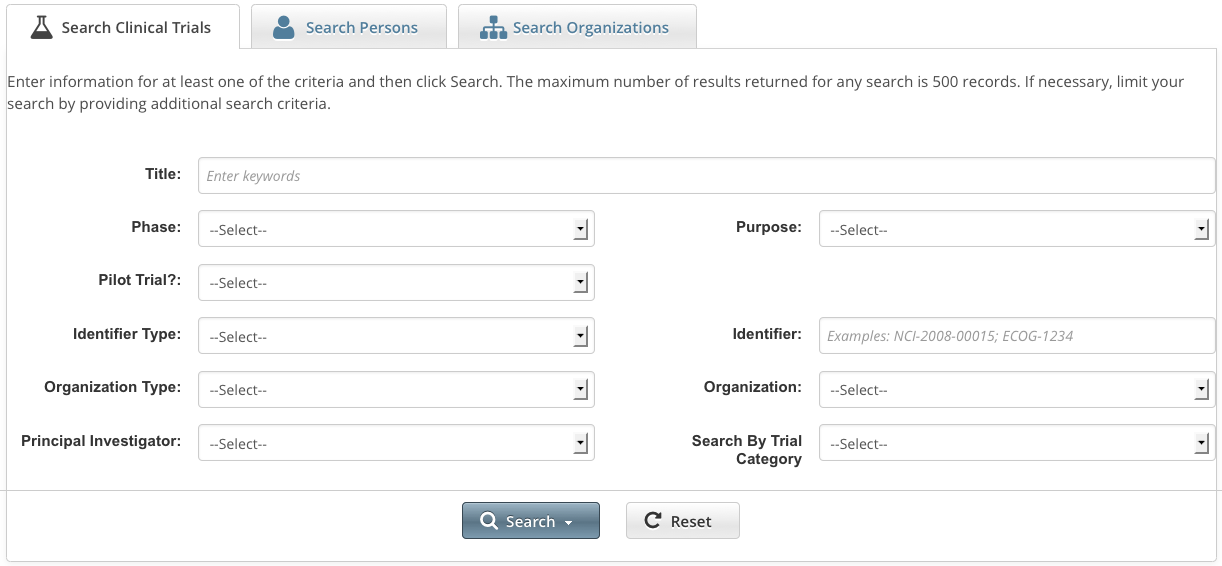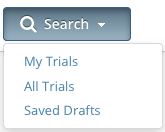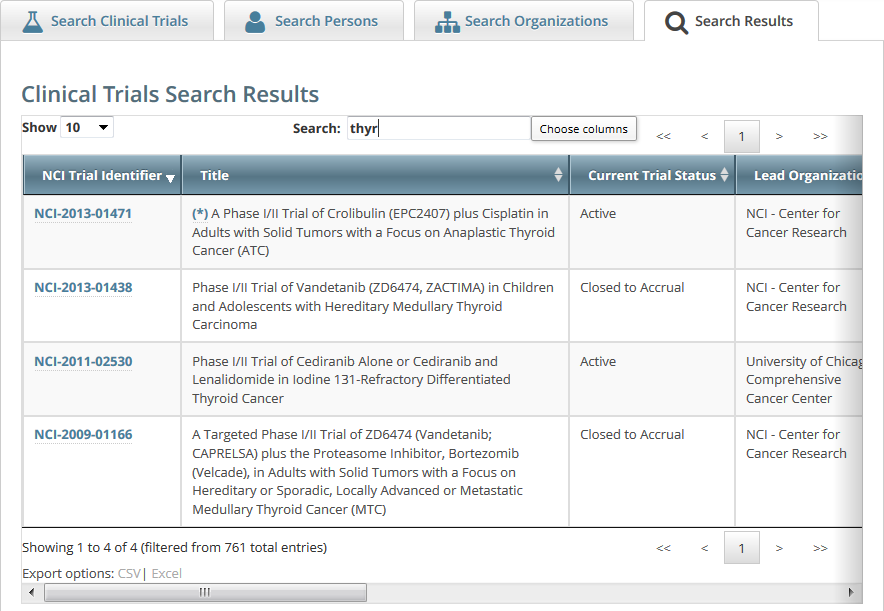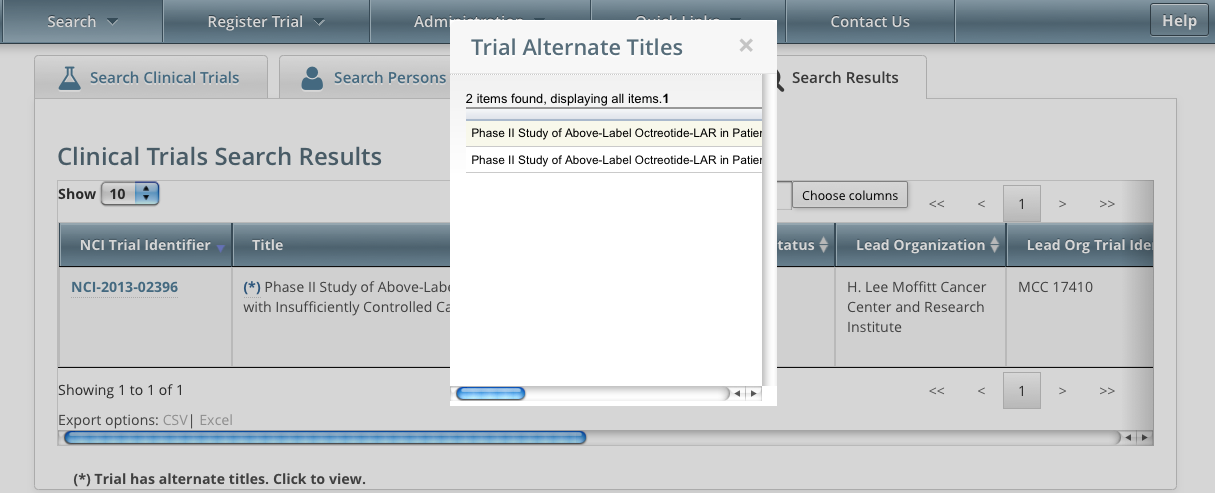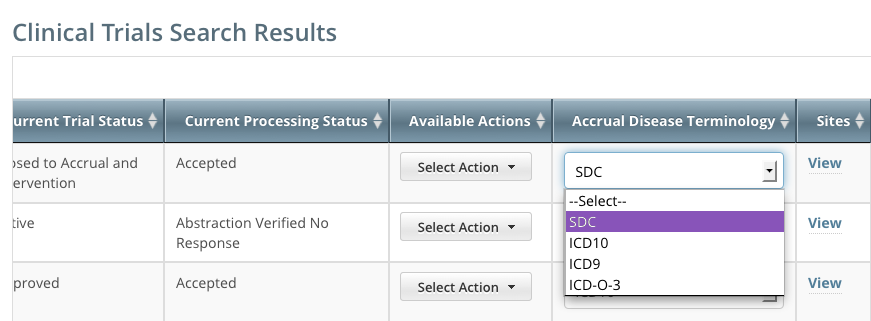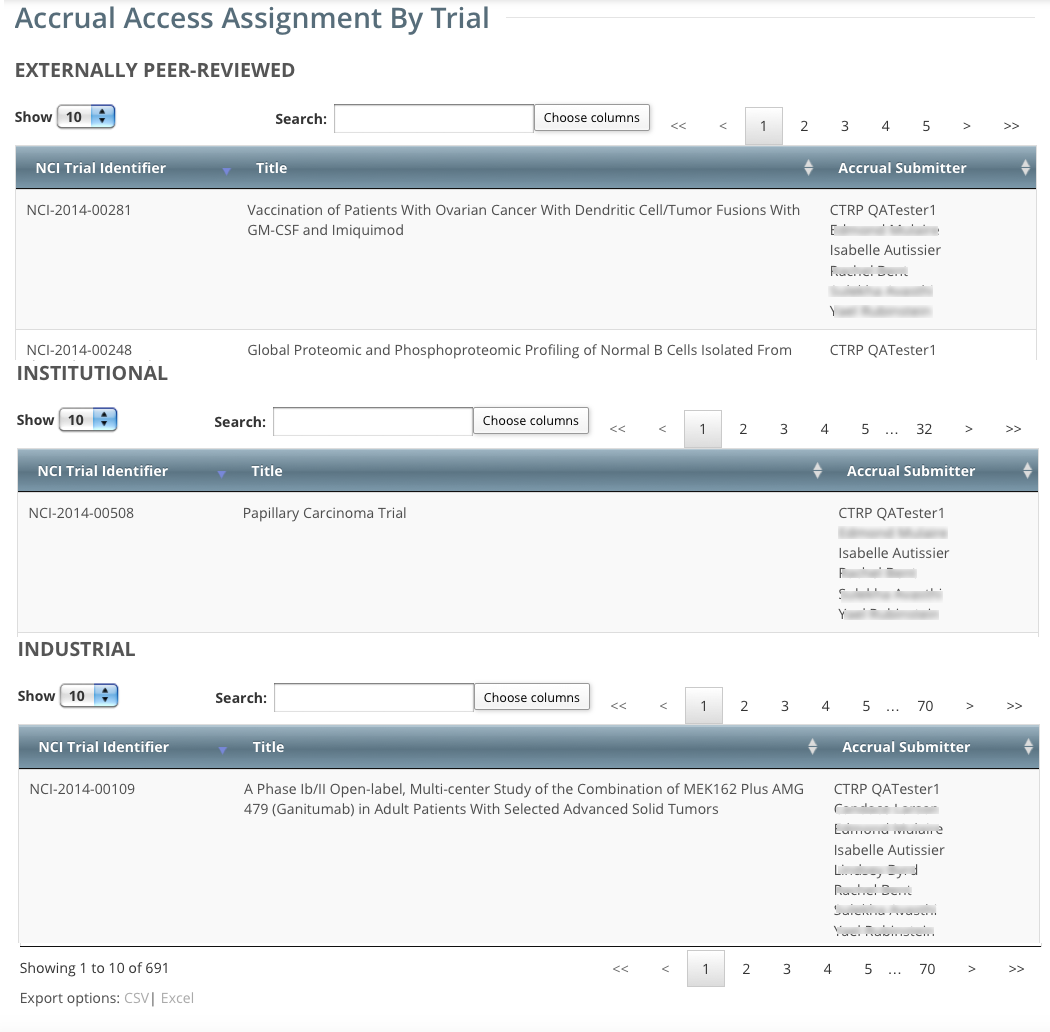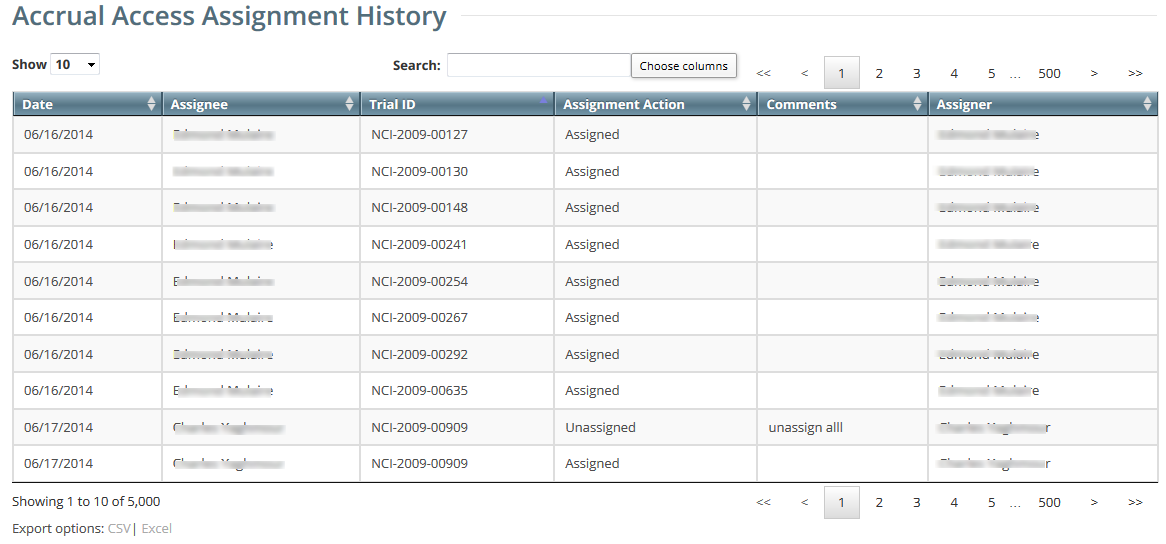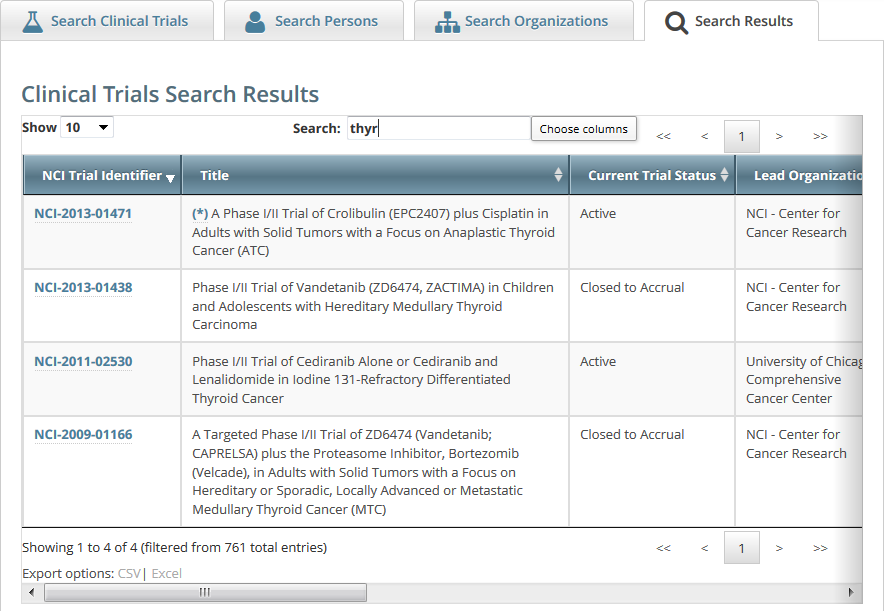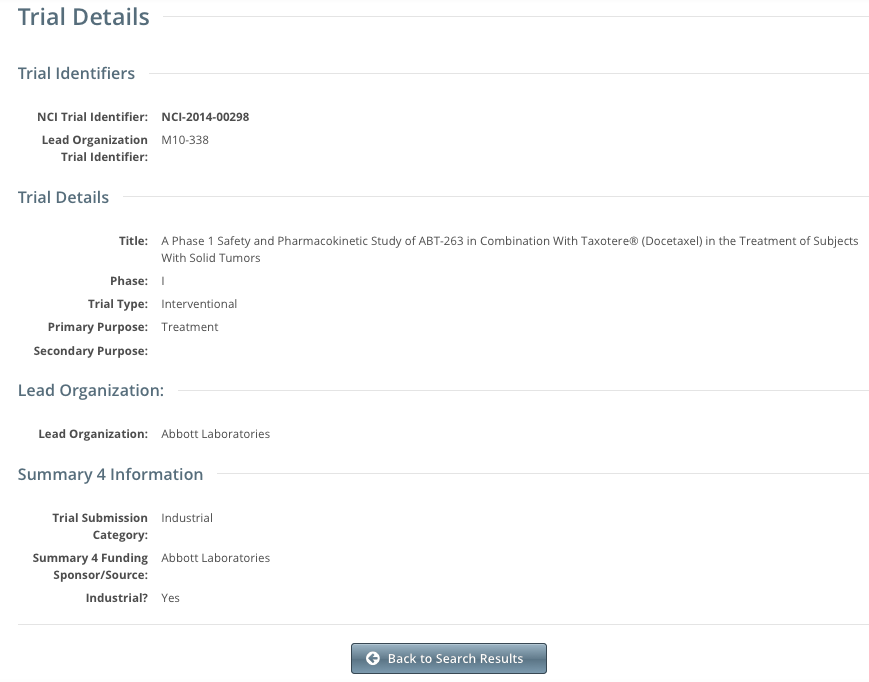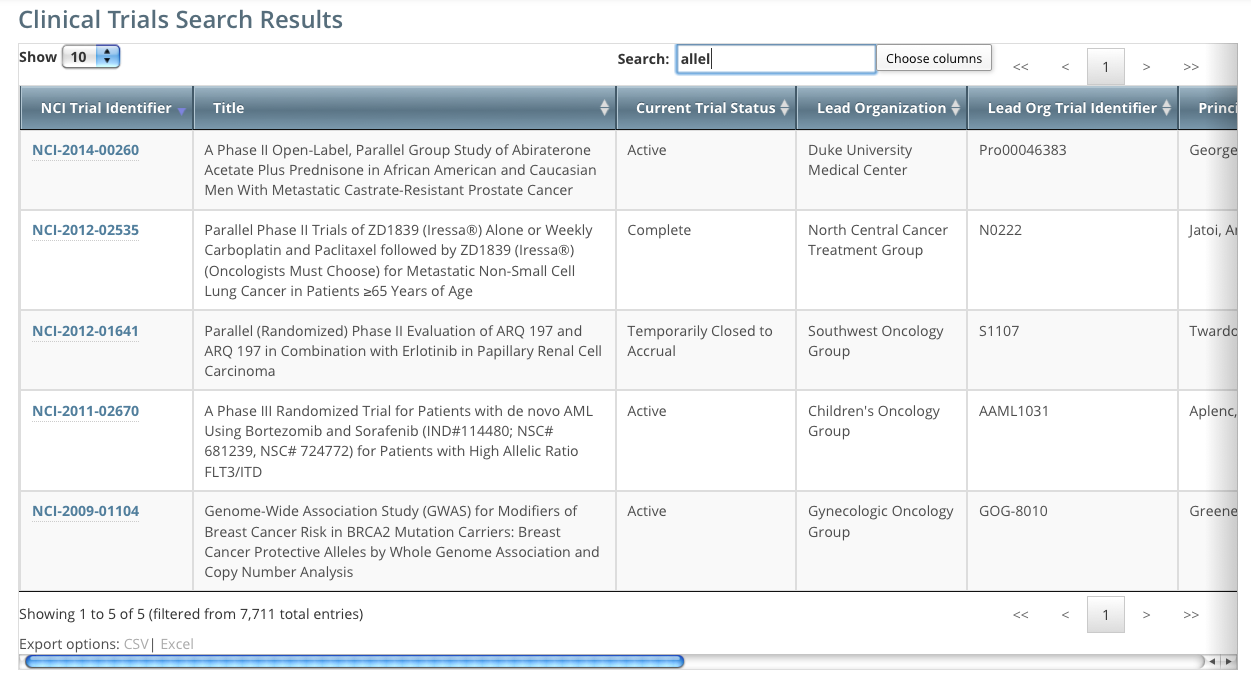- Getting Help
- Adding Sites
- Amending Trials
- Converting Documents to PDF
- Displaying Trial Ownership
- Editing Trial Details
- Granting and Revoking Administrative Authority
- Managing Access to the Subject Accrual Application
- Managing Participating Site Record Ownership
- Managing Program Codes and Targeted Accrual
- Managing Trial Ownership
- Managing Your Account
- Registering Industrial and Other Trials
- Registering New Complete Trials
- Searching for Organization Records
- Searching for Person Records
- Searching for Trial Records
- Trial Status Rules for Start and Completion Dates
- Updating Trials
- Verifying Trial Data
- Viewing Accrual Assignment History by Trial
- Viewing Accrual Assignment History in Registration
- Viewing Trial Details
- Working with Clinical Trial Search Results
This page is simply a wiki shortcut.
This page displays subject matter that is included, in context, in many of the web pages that constitute the CTRP application user's guides.
Getting Help
This page contains select topics that help you to understand and use the NCI CTRP Registration application. You can find more comprehensive documentation in the NCI CTRP Registration User Guide.
If you are experiencing technical issues with the CTRP web application, or if you have questions, contact us at ctrp_support@nih.gov. When submitting support requests, include:
- Your contact information, including your telephone number
- The name of the application/tool you are using
- The relevant URL
- A description of the problem and steps to recreate it
- The text of any error messages you have received
For other CTRP topics, contact the Clinical Trials Reporting Office (CTRO) at ncictro@mail.nih.gov.
Adding Sites
(To add your organization as a participating site to a Complete trial, contact the lead organization.)
| Trial Attribute | Requirement |
| Lead Organization | Not an organization in RSS |
| Your Organization | Not currently participating in the trial |
| Trial Processing Status | Accepted or beyond |
Once added, you can update your site's record at any time.
Trial information that you can update after adding your site includes the following:
- Organization's local trial identifier
- Site principal investigator
- Organization family's program codes
- Site recruitment status and dates
How to Add Your Organization as a Participating Site
- Select the trial that your site is participating in. The Available Actions column in the search results table displays actions currently available for the trial.
In the Available Actions column, click the Select Action button and click Add My Site. The Add Participating Site page appears. The Participating Site list contains all organizations in the Organization Family associated with your CTRP account.
From the Participating Site list, select the organization that you want to add to this trial. Click Next. Another Add Participating Site page appears.
- In the Local Trial Identifier field, enter the identifier used at the participating site.
- Next to the Site Principal Investigator field, click Look Up to search for and select the site principal investigator.
(Optional) Specify a contact for the trial at this participating site. You can do so in one of the following ways:
Next to the Site Primary Contact field, click Look Up to search for and select the site primary contact.
- Next to the Generic Contact field, click Look Up Generic Contact to search for and select a CTRP person record.
- (Optional) Consider whether the default contact information for the selected person record is appropriate for the trial at this participating site. The system accepts either the contact’s primary telephone number or the contact’s primary email address. You can provide both if available. Enter the phone number in the format 123-456-7890. You can provide an extension if available.
- (Optional) In the Program Code field, select one or more program codes for the trial. The Program code field lists all program codes available for the organization family.
Add site recruitment status information:
Select or enter the appropriate information in the text fields and drop-down lists. The following table describes the fields. An asterisk (*) indicates a required field.
Field
Description/Instructions
Site Recruitment Status Date*
Enter the date on which the current trial status became effective.
To ensure that you record valid status dates, review the information provided in CTRP System Rules for Study Status and Dates.
Site Recruitment Status*
Select the current stage or state of the trial or study.
The system validates all status transitions when you save a status record. If you add or update a status transition that does not conform to the rules provided in Status Transition Rules, the system displays errors and/or warnings. Warnings indicate that fixing the status record is optional; you do not have to resolve the transitions. However, Errors indicate that you must resolve the transitions by correcting trial status records.
Click Add Status. The Site Recruitment Status History section appears, displaying the site recruitment information you entered.
- Repeat the process of entering a status date, entering a status, and clicking Add Status until you have entered all statuses for the site.
- If the system displays Errors or Warnings indicating that the status you added is invalid, do one of the following.
To edit the status, in the Actions column, click the Edit icon. Then, in the Edit Trial Status dialog box, make changes as indicated in the Error and/or Warning message.
- To delete the status, in the Actions column, click the Delete icon. Enter a comment indicating the reason why you deleted the record. Then add the correct status information.
Click Save. Your information is added to the trial details.
Amending Trials
- You can create a new NIH grant record only if you can provide all of the following details:
- Funding Mechanism
- NIH Institution Code
- Serial Number
- NCI Division/Program
- You can not change the following existing information:
- NCI trial identifier number
- NIH grant number
- IND/IDE serial number
- The following list is the minimum set of required documents that must be submitted with each amendment:
- Protocol document.
- IRB approval document.
A change memo document or protocol highlighted document:
A change memo is a document that contains a summary of changes as compared to the original, or last amended, trial submission.
A protocol highlighted document is a document that has been marked up, with or without using a Track Changes feature.
List of participating sites and contact information (for multi-site trials, if not included in the protocol document).
Informed consent (if not included in the protocol document) and only when there are documented changes to the consent.
When you are submitting an amendment, we recommended that you provide any additional documents that you think will be useful to the CTRO for reviewing and processing the amendment document.
A trial may have more than one owner. Review the recorded information carefully to see if another owner has modified the trial.
- Dose Escalation Amendment (change in the number of patients treated at a given dose level)
- Change in Sites Open to Patient Accrual
- Change in Principal Investigators
- Change in Risk to Participants (new risk identified [new CAEPR], changes made as a result of an updated Severe Adverse Event)
- Scientific Change (opening an arm, adding a new arm, closing an arm, changing objectives, changing statistical analysis, adding correlative studies, increase or decrease in the accrual goal, changing from Phase I to Phase II, additional data points)
- Correction of Typographical Errors which Change Scientific Meaning (mg vs. mcg)
- Eligibility Change (change to the inclusion or exclusion criteria)
- Therapy Change (change in dose, adding another agent, change in administration, change in route)
To open the trial record for amending, refer to Amending Trials.
- On the toolbar, click Search > Clinical Trials. The Search Trials page appears.
- Click Search > My Trials. The Search Results page displays the results of your search and actions available (if any) for each record.
In the Available Actions column, click Select Action > Amend. The Amendment Trial page displays the data currently registered with the CTRP.
Make changes to the fields as necessary. The system requires you to provide information for all fields marked with an asterisk (*). The instructions are the same for trial registration and trial amendment, with some exceptions:
In the Amendment Details section, specify the appropriate information in the various fields. The following table describes the fields.
Field Label Description/Instructions Amendment Number
Enter an appropriate number.
Amendment Date* Select or enter an appropriate date. A trial can accumulate program codes from different organization families. For example, a participating site might belong to a different organization family than the lead organization. When you amend a trial, the Program Code field displays all codes from the master list for the organization family of the lead organization.
Primary Completion Dates are optional for non-interventional trials and for DCP trials. In both cases, the system excludes such trials when submitting XML documents to ClinicalTrials.gov. Otherwise, Primary Completion Dates are required.
For instructions on recording each field otherwise, refer to Registering New Trials.
- Review the amendment. Refer to Reviewing and Submitting Trial Amendments.
- Submit the amended trial to the CTRP. The system sends you an email notification — with the details of what has changed — whenever you amend accepted trials.
Converting Documents to PDF
Trial-related documents uploaded as Microsoft Word (.doc), Microsoft Excel (.xls, .xlsx, .xlsm, or .xlsb), and WordPerfect files contain text that abstractors can copy and paste directly. PDFs (portable document format) contain text that abstractors can copy only if the content was created from other text-based applications such as Word or Excel.
Abstractors can not copy and paste text from scanned documents
Avoid uploading PDFs of scanned documents. They can not be edited, copied, or read with OCR (optical character recognition) applications.
Microsoft provides instructions for converting files to PDFs both on their website and in the Help documentation in each of its applications.
When searching for help, use "save file as pdf" as the search term.
You do not need a document converter in Mac OSX. Instead, print your documents to a PDF file.
How to Convert Text-Based Files to PDFs in Mac OSX
- Open your text file in its original format (such as .doc or .xls).
- Click File > Print.
- In the Print window, click the PDF button at the bottom-left and select the Save as PDF option.
- Choose the file location, rename your PDF file, and then click Save.
Displaying Trial Ownership
- View trial details
- Update trials
- Amend Complete trials
- Access TSR and XML documents
As a Site Administrator, you can display trial ownership for any trial for which your organization or its family member organization is the lead organization. Additionally, you can indicate whether a user would like to receive system notifications, including TSRs and XML files, on a trial-by-trial basis.
How to Display Trial Ownership
- On the toolbar, click Administration > Trial Ownership > View. The Display Trial Ownership page displays the current owner(s) of the trials for which your organization is the lead organization. It also indicates which of the owners, for each of the trials, receive system-generated email notifications.
- You have the following search options:
- To display all the trials owned by a given user, search for the user by first name, last name, or email address, and then click Search. The system lists all trials owned by the user in the Search Results list.
To display all owners of a given trial, enter the NCI Identifier in the field provided, and then click Search. The system lists all owners of the selected trial in the Search Results list.
- You have the following options to manage trial ownership:
Indicate whether or not an owner of a trial should receive system-generated email messages. To do so, in the Receive Email? column, select Yes or No.
Selecting Yes indicates that you want the owner to receive all notifications regarding the specified trial.
Selecting No indicates that you do not want the owner to receive any notifications regarding the specified trial.
- To revoke ownership of a trial, locate the user/trial in the Search Results list, and then click Remove.
- You have the following additional options:
To filter the search results, in the Search field, type one or more characters contained in any of the fields. The system filters the list as you type each character. For details, refer to Working with Tables and Search Results.
To create more space on the page, on the upper right corner of the page, select the Hide Search Criteria check box.
Editing Trial Details
How to Edit Updated Details
Scroll to the bottom of the Review Trial Details page, and click Edit. The Update Trial page displays all information you have provided, in editable form.
Make changes as necessary and then review the trial again. For instructions, refer to Reviewing and Submitting Trial Updates.
Granting and Revoking Administrative Authority
- The CTRO or another Site Administrator has granted the user profile the administrative rights.
- The user profile is affiliated with that site (an organization family or a single organization that does not belong to an organization family).
The relationships between Site Administrators and trials in a single site are as follows:
- An organization:
- Can have one original Site Administrator.
- Can have many Site Administrators appointed by the original Site Administrator.
- Can be the lead organization for many trials.
- Can be the affiliated organization for many users who can submit and own trials.
- A trial:
- Can have one submitter.
- Can have one organization affiliation, defined by the lead organization.
Can have many trial owners.
- Trial ownership:
- Can be implicit. By default, if a Site Administrator's affiliated organization is the lead organization for a trial, that Site Administrator is an implicit owner of that trial.
- Can be explicit. By default, the trial submitter is the only explicit trial owner. A Site Administrator can grant ownership of a trial to more users and can remove trial ownership from the original submitter and other users. (Refer to Managing Trial Ownership.) If you add a Site Administrator as an owner of a trial, that Site Administrator has explicit ownership of that trial, rather than just implicit ownership.
- A Site Administrator can do the following:
- Display trial ownership
- Manage trial ownership
- Manage site record ownership
- Manage accrual access
- Manage the administrative rights of other users in the organization
Revoke own administrative rights
Site administrators do not receive system-generated emails automatically
The system sends generated emails (including TSRs) to a Site Administrator only if the Site Administrator's affiliated organization is the trial's lead organization, or if the Site Administrator is the trial submitter and/or trial owner. The Site Administrator can also manage email notification globally. For instructions, refer to Managing Registration Email Notifications.
As a Site Administrator, you can grant and revoke administrative rights to other users in your organization. (You can grant/revoke administrative rights to users who have a CTRP account and whose organizational affiliation is the same as your own.) Site Administrators are the only Registration users who can access the Site Administration menu.
How to Grant and Revoke Site Administrative Rights
- On the toolbar, click Administration > Site Administration. The Site Administration page appears, listing Registration users and indicating which ones have previously been granted administrative rights.
- Search for the Registration user for whom you want to adjust administrative rights: Specify the user by first name, last name, or email address, and then click Search. The user's name appears in the Search Results list.
To promote the user to Site Administrator, select the check box in the Allow as Site Admin? column.
As a Site Administrator, you can revoke your own administrative rights. Use caution if you do so because you can not promote yourself thereafter.
To revoke administrative access, clear the check box in the Allow as Site Admin? column.
- Click Save.
Managing Access to the Subject Accrual Application
Assignment at the organization level pertains to trials that the organization has registered in CTRP and extends to those that it will register in the future. Similarly, assignment at the organization family level pertains to trials that any member organization has registered in CTRP and extends to those that it will register in the future.
Only the CTRO has access to CTEP and DCP trial accruals.
The table below outlines the access and trial assignment rules for Complete and Abbreviated trials.
| Access/Assignment | Complete Trial | Abbreviated Trial |
|---|---|---|
| Who can assign access? |
|
|
| To whom can you assign access? | Any registered user affiliated with the Site Administrator's organization, or family member organization (including the Site Administrator) | Any registered user affiliated with the assigner's organization (including the Site Administrator) |
| What types of trials can you assign? | Complete trials for which the assigner's organization is the lead organization | Abbreviated trials for which the assigner's organization is the lead organization or participating site |
| How can you assign access? |
The system automatically assigns the organization family Accrual Submitter access to any trial registered by new organizations added to an organization family in the future. It withdraws access if anyone removes the organization family Accrual Submitter's organization from the organization family in the future. |
|
| Who can submit accrual data? | Any assigned user affiliated with the lead organization, or with a lead organization that is a member of the user's affiliated organization family | Any assigned user affiliated with the participating site |
| To which trials can the organization family Accrual Submitter submit accrual data? |
|
|
For instructions, refer to the following pages:
Managing Participating Site Record Ownership
On the toolbar, click Administration > Trial Ownership > Manage. The Manage Trial Ownership page displays the following lists:
At the top of the page: The names of users affiliated with your affiliated organization or its family member organization(s).
Below the list of names: Trials on which your organization is a lead organization or participating site.
- Under Manage trial record ownership for, select which role your affiliated organization or its family member organization(s) play(s).
- For Complete trials, select Lead Organization.
- For Abbreviated trials, select Participating Site.
Indicate which users you want to give the ability to update and amend selected Complete trials; or update Abbreviated trials. To do so, select one or more user names on the list.
You can select or deselect all names, or filter the list of names
To select all names, select the check box on the left side of the column heading. Click it again to deselect all names.
To filter the list of names, in the Search field, type one or more characters contained in a user's name or email address. The system filters the list as you type each character.
In the list of trials at the bottom of the page, under All Available Trials, or All Available Abbreviated Trials, select the trials to assign to the user(s), and then click the Assign icon ( > ).
To unassign trials, under Trial Ownership Assignments, or Site Owner Assignments, select the user(s) you want to unassign, and click the Unassign icon ( < ).
For Complete trials, indicate which trial owners should receive email notifications about the trial(s):
To indicate that a specific user should or should not receive email, in the Email Notification? column, in the row for that user, click Yes or No.
To indicate that all owners should or should not receive email, in the Email Notification? column header, click All > Select Yes/No for all.
The Select No for All and Select Yes for All options apply globally to all trial owners, not just the ones currently visible in the list.
Managing Program Codes and Targeted Accrual
This section describes how to:
Manage the set of program codes and program code assignments for the organization family. Most of this section provides instructions for that task.
- Manage targeted accrual, the total number of participants expected to accrue at all of the sites within your organization family participating on a study. For instructions, refer to Managing Targeted Accrual.
- Specify the Center Principal Investigator for a trial. For instructions, refer to Specifying the Center Principal Investigator.
- Specify the local trial ID for a trial. For instructions, refer to Managing Local Trial IDs.
For instructions, refer to the following pages:
Using the Manage Program Codes Master List Page
Viewing Program Codes
- On the toolbar, click Administration > Manage DT4 Information > Manage Program Code Master List. The Manage Program Codes Master List appears.
Notice that this page displays information specific to your organization family.
You can navigate through the list of program codes just like any other list of search results in the CTRP Registration application. For instructions, refer to Working with Tables and Search Results.
Adding Program Codes
- On the Manage Program Codes Master List page, in the Program Code field, enter a unique program code. This is likely to be a very short representation of the program.
- (Optional) In the Program Name field, enter a program name.
- Click Add Program Code. The new program code appears in the list.
For each organization family, active program codes must be unique. The list may contain two entries with the same program code, if one is active and the other is inactive.
Editing Program Codes
- On the Manage Program Codes Master List page, in the row for the program code of interest, click the Edit icon (). The Edit Program Code dialog box appears.
- Change the program code, program name, or both.
- Click Save.
- If you have changed only the program name, the list reflects your change.
- If you have changed the program code, a confirmation message appears. If you want to proceed, click Yes. The list reflects your change.
Deleting or Inactivating Program Codes
- On the Manage Program Codes Master List page, in the row for the program code of interest, click the Delete icon (). The system checks whether the selected program code has been assigned to any trials. What happens next depends on the result of that system check:
- If the selected program code has not been assigned to any trials, then a message appears, asking you to confirm the deletion.
- Otherwise, a dialog box appears with details, asking you to confirm the inactivation.
- If the selected program code has not been assigned to any trials, then a message appears, asking you to confirm the deletion.
- After reading the provided information, confirm or cancel the action:
- To confirm deletion, click Delete. To confirm inactivation, click Yes. The list changes to reflect your action:
- If you deleted a program code, the system removes the program code completely.
- If you inactivated a program code, the system removes the program code from only trials that were active at any time during the reporting period (For instructions on changing the reporting period, refer to Viewing the Assignments for a Program Code). You can no longer assign this program code to trials. For trials with this program code outside of the reporting period, the system appends “-inactive” to the program code.
- To cancel deletion, click Cancel. To cancel inactivation, click No.
- To confirm deletion, click Delete. To confirm inactivation, click Yes. The list changes to reflect your action:
Viewing the Assignments for a Program Code
On the Manage Program Codes Master List page, in the row for the program code of interest, click the View icon (). The Manage DT4 Information for Your Center page appears.
- Notice that this page displays information specific to a date range:
- The default end date is 12/31/2015. In the Reporting Period End Date field, consider specifying a different date.
- The default reporting period length is 12 months. In the Reporting Period Length field, consider specifying a different number.
- Notice that this page displays a list of trials that meet all the following criteria:
- Trials in which any member of your organization family is a participant.
- Trials assigned the program code that you selected on the Manage Program Codes Master List page.
- Trials with any of the following statuses at any time within the reporting period, as specified on this page:
In Review
Approved
Active
Enrolling by Invitation
Temporarily Closed to Accrual
Temporarily Closed to Accrual and Interventions
- If you want to adjust the list filter, instructions depend on whether the list is already filtered:
- If the list has been filtered, in the Program Code(s) column header, click the button that indicates the number of program codes selected. The list includes all program codes for the organization family and other options.
- If the list has not been filtered yet, in the Program Code(s) column header, click the filter icon (). The Select Program Code(s) button appears. Click Select Program Code(s). The list includes all program codes for the organization family and other options.
- Select one or more program codes from the list. (To select all program codes or deselect all program codes, toggle the Select/Deselect All option. To display trials that have not been assigned to program codes, select None.) The system updates the list of trials to reflect your selections.
You can navigate through the list of trials just like any other list of search results in the CTRP Registration application. For instructions, refer to Working with Tables and Search Results. On the Manage Program Code Assignments page, in the Search box, if you include the search term in double quote marks (for example "cancer"), the search results include trials that have an exact match in any of the first five columns.
Using the Manage DT4 Information for Your Center Page
Replacing a Program Code
- On the Manage DT4 Information for Your Center page, select one or more trials that have been assigned to program codes.
- Click Replace (at the bottom of the page). The Replace Program Code Assignments dialog box appears with two lists. The first list includes all program codes assigned to any selected trial.
- In the first list, select the program code that you want to replace. The second list includes all program codes for the organization family. However, the one you selected in the first list becomes unavailable for selection in the second list.
- In the second list, select one or more target program codes.
- Click OK. The Program Code(s) column reflects your changes.
Assigning Program Codes to Multiple Trials
- On the Manage DT4 Information for Your Center page, select one or more trials of interest.
- Click Assign (at the bottom of the page). The Assign Program Codes dialog box appears. The list includes all program codes that you can assign to the selected trials.
- In the list, select one or more target program codes.
- Click OK. The Program Code(s) column reflects your changes.
Assigning a Program Code to a Single Trial
- On the Manage DT4 Information for Your Center page, in the row for the trial of interest, in the Program Code(s) column, click the v icon.
The Program Code field appears.
- Click the Program Code field. The list includes all program codes for the organization family, but the ones already assigned to the selected trial are unavailable for selection.
- Select the target program code. The Program Code(s) column reflects your changes.
You can also assign a program code to a trial while performing the following tasks:
- Registering, amending, or updating a Complete trial. For instructions, refer to Registering New Trials, specifically Recording Data Table 4 Information.
- Adding your site after importing a trial. For instructions, refer to Registering Abbreviated (Industrial and Other) Trials.
- Adding a participating site to an Abbreviated trial or updating such a site (as a site affiliate). For instructions, refer to Adding Your Site to Abbreviated Trials.
- Adding participating sites to Abbreviated trials (as a Site Administrator). For instructions, refer to Adding Sites.
Unassigning Program Codes from Multiple Trials
- On the Manage DT4 Information for Your Center page, select one or more trials that have been assigned to program codes.
- Click Unassign (at the bottom of the page). The Unassign Program Codes dialog box appears with a list of all program codes, but only the ones assigned to the selected trials are available for selection.
- In the list, select one or more program codes.
- Click OK. The Program Code(s) column reflects your changes.
Unassigning a Program Code from a Single Trial
You can also unassign a program code from a trial while performing the following tasks:
- Amending or updating a Complete trial. For instructions, refer to Registering New Trials, specifically Recording Data Table 4 Information.
- Adding a participating site to an Abbreviated trial or updating such a site (as a site affiliate). For instructions, refer to Adding Your Site to Abbreviated Trials.
- Adding participating sites to Abbreviated trials (as a Site Administrator). For instructions, refer to Adding Sites.
Viewing Your Participation
- On the Manage DT4 Information for Your Center page, in the row for the trial of interest, in the Lead Organization column, click Show my participation. The Participating Sites dialog box appears, listing only the participating organizations that are members of your organization family.
- When you are done viewing the list of participating sites, click Close.
Managing Targeted Accrual
On the toolbar, click Administration > Manage DT4 Information > Manage DT4 Information for Your Center. A page by that name appears.
- In the row for the trial of interest, in the Targeted Accrual for Your Center column, specify the targeted accrual:
- Click the existing value (or Empty). A text box appears.
- Change the value or enter a new one. When done, click the check mark. The system saves your changes.
- Click the existing value (or Empty). A text box appears.
This value appears in the Your Center Total column of the Data Table 4 report. For instructions on generating that report, refer to Running CTRP Data Table 4 Reports.
Specifying the Center Principal Investigator
On the toolbar, click Administration > Manage DT4 Information > Manage DT4 Information for Your Center. A page by that name appears.
- If you want to specify a different person, in the row for the trial of interest, in the Center Principal Investigator column, click Look Up. For instructions, refer to Looking Up Registered Persons.
This value appears in the PI columns (Last Name, First Name, Middle Initial) of the Data Table 4 report. For instructions on generating that report, refer to Running CTRP Data Table 4 Reports.
Managing Local Trial IDs
On the toolbar, click Administration > Manage DT4 Information > Manage DT4 Information for Your Center. A page by that name appears.
- In the row for the trial of interest, in the Local Trial ID column, enter your site's ID for the trial:
Click the existing value (or Empty). A text box appears.
- Change the value or enter a new one. When done, click the check mark. The system saves your changes.
The system does not use the Local Trial ID column to generate the Data Table 4 Report. Field values will not be copied into the Center Local Trial ID field (in Registration) of the Data Table 4 report. For instructions on generating that report, refer to Running CTRP Data Table 4 Reports.
Managing Trial Ownership
On the toolbar, click Administration > Trial Ownership > Manage. The Manage Trial Ownership page displays the following lists:
At the top of the page: The names of users affiliated with your affiliated organization or its family member organization(s).
Below the list of names: Trials on which your organization is a lead organization or participating site.
- Under Manage trial record ownership for, select which role your affiliated organization or its family member organization(s) play(s).
- For Complete trials, select Lead Organization.
- For Abbreviated trials, select Participating Site.
Indicate which users you want to give the ability to update and amend selected Complete trials; or update Abbreviated trials. To do so, select one or more user names on the list.
You can select or deselect all names, or filter the list of names
To select all names, select the check box on the left side of the column heading. Click it again to deselect all names.
To filter the list of names, in the Search field, type one or more characters contained in a user's name or email address. The system filters the list as you type each character.
In the list of trials at the bottom of the page, under All Available Trials, or All Available Abbreviated Trials, select the trials to assign to the user(s), and then click the Assign icon ( > ).
To unassign trials, under Trial Ownership Assignments, or Site Owner Assignments, select the user(s) you want to unassign, and click the Unassign icon ( < ).
For Complete trials, indicate which trial owners should receive email notifications about the trial(s):
To indicate that a specific user should or should not receive email, in the Email Notification? column, in the row for that user, click Yes or No.
To indicate that all owners should or should not receive email, in the Email Notification? column header, click All > Select Yes/No for all.
The Select No for All and Select Yes for All options apply globally to all trial owners, not just the ones currently visible in the list.
Managing Your Account
Changing your Organizational Affiliation results in loss of privileges
If you change your organizational affiliation, the system revokes your existing Site Admin and Accrual Submission privileges.
How to Edit Your Account Information
- Visit the CTRP Registration home page at https://trials.nci.nih.gov/registration.
- Log in.
- On the top right corner of any page, click Your Username > My Account.
The My Account page appears, populated with the information you previously supplied for your account. In the Your Account Profile section, make any changes as necessary, and then click Save.
Registering Industrial and Other Trials
The system registers the trials you import from ClinicalTrials.gov as Abbreviated trials. To classify a trial as "Other", contact the Clinical Trials Reporting Office staff at ncictro@mail.nih.gov after importing/registering the trial in the CTRP system.
For more information about Data Table 4 categorization, see Guidelines for Abbreviated Trials.
How to Register Industrial Trials
On the toolbar, click Register Trial, and select Industrial/Other.
To read a definition of each of the trial submission categories (study sources), click View Trial Category Definitions, or, click the Help icon () next to each category.
The Import ClinicalTrials.gov Trials page appears.
Enter the ClinicalTrials.gov Identifier, and then click Search Studies. The system searches for the ID you entered. If it finds a match in the CTRP, you can not import the trial.
If the system does not find a match in the CTRP, the trial record from ClinicalTrials.gov appears.
Click Import Trial From ClinicalTrials.gov.
While it is possible for two users to attempt to import a trial at the exact same time, the system cannot process simultaneous imports. If you receive an error message the first time you attempt to import a trial, wait a short while, and then try again.
The trial is registered in the CTRP and assigned a unique NCI identifier with the processing status Submitted. The system synchronizes the imported record in the CTRP with the one in ClinicalTrials.gov.
To add your site as a participant in the trial, click Add My Site. The Add Participating Site page appears. The Participating Site list contains all organizations in the Organization Family associated with your CTRP account.
From the Participating Site list, select the organization that you want to add to this trial. Click Next. Another Add Participating Site page appears.
Complete the fields as per the instructions in Adding Your Site to Abbreviated Trials, and then click Save. The system sends you an email message when the CTRO has accepted the trial for registration in the CTRP. If your trial is not Industrial, contact the CTRO at ncictro@mail.nih.gov to request categorization of the trial as either National or Externally Peer-Reviewed.
The system synchronizes Industrial and Other trials currently registered in the CTRP with ClinicalTrials.gov trials every night by comparing their ClinicalTrials.gov Identifiers. The system updates CTRP trial records with the data imported from ClinicalTrials.gov if it finds matching records.
The CTRP system does not import Person information from ClinicalTrials.gov.
Registering New Complete Trials
How to Register New Complete Trials
Perform a search for the trial. For instructions, refer to Searching for Trial Records. If the trial does not already exist, proceed to the next step. (The system uses the Lead Organization ID, Lead Organization Trial ID, and the ClinicalTrials.gov Identifier to detect duplicates. If the system detects a duplicate, the system does not record your trial.)
On the toolbar, click Register Trial, and select your trial's Submission Category (funding source) from the drop-down list, either National, Externally Peer-Reviewed, or Institutional. (For information, refer to CTRP Trial Categories, Study Sources.)
To read a definition of each of the trial submission categories (study sources), click View Trial Category Definitions, click the Help icon () next to each category, or refer to https://cancercenters.cancer.gov/GrantsFunding/eData#dt4.
The Register Trial page appears.
You can expand and collapse sections of the registration page
By default, all sections of the registration form are displayed.
To collapse or expand each section individually, click the Collapse or Expand icon on the right side of the section title as shown in the figures below.
To collapse all sections, click Collapse All.
In the various fields, specify the appropriate information. The following table describes the fields.
Tip
Be sure to provide information for all fields marked with an asterisk (*). If you cannot complete the registration of a trial in one Registration session, you can save a draft of the trial details you have completed. (Refer to "Save as Draft" below.) Later you can return to complete the registration in another session.
Field Label Description/Instructions Various
In the various fields, specify information as appropriate according to the detailed instructions provided for each of the following sections:
- Recording Trial Identification Information
- Recording Trial Details
- Recording Lead Organizations and Principal Investigators
- Recording Sponsors and Responsible Parties
- Recording Data Table 4 Information
- Recording NIH Grants
- Recording Trial Statuses
- Recording Trial Dates
- Recording INDs and IDEs
- Recording Regulatory Information
- Uploading Trial-Related Documents
Save as Draft
Click to save a draft of the record so that you can complete the registration at another time. You must have provided, at the minimum, both the Lead Organization and Lead Organization Trial Identifier to save a draft.
The system saves your draft, assigns it a unique ID (for tracking purposes), and sends you an email message confirming that the information has been saved. You can end your Registration session and retrieve your draft later to complete the registration.Review Trial
Click to initiate the system check for errors and missing information. The system displays the results in a message at the top of the Review Trial Details page. Indicators mark specific fields that you must complete or correct in order to submit the trial.
The Review Trial Details page is read-only. To make changes to the trial data, follow the instructions in Editing Trial Details.Cancel Click to cancel the registration. A pop-up message prompts you to confirm cancellation.
If you choose to cancel the registration, you will lose all data that you may have entered.
To continue with the trial registration, scroll to the bottom of the Review Trial Details page, and then click Submit. To prevent creating a duplicate record, do not click Submit more than once. If you have to make changes after you click Submit, contact the CTRO at ncictro@mail.nih.gov rather than using your browser's Back button to make changes.
The registration notification message system sends you an email message to acknowledge that the trial has been submitted. Later it sends another email message to notify you when your trial has been accepted or rejected.
After submission, most users other than the trial submitter can not see the trial information you provided until the information has been validated. However, an organization administrator (if one exists) and an assigned owner can access the information prior to validation.
Searching for Organization Records
- Organization Identifying Information
- PO ID - Enter the exact PO ID only
- CTEP ID - Enter all or part of the CTEP ID
- Name - Enter all or part of the Organization's name
- Family Name. Enter all or part of the Organization Family's name
- Organization Address
- Country - Select the country from the drop-down list
- City - Enter all or part of the organization's primary location
- State - Select the state from the drop-down list
- Zip Code - Enter all or part of the Zip code
- Organization Type. Select one of the following:
- Lead Organization - Returns organizations that are Lead Organizations
- Participating Site - Returns organizations that are Participating Sites
- Both - Returns organizations that are either Lead Organizations or Participating Sites
How to Search for Registered Organizations
- Click the Search Organizations tab. Or, on the toolbar, click Search > Organizations.
Provide as much information as you can about the organization you are looking for, or, enter the Person/Organization (PO) ID or Cancer Therapy Evaluation Program (CTEP) Identifier. You must enter search criteria in at least one field.
Searching by PO ID
The PO ID you enter for your search criterion must be exact and complete. That is, do not use partial IDs or wildcards.
Using wildcard characters ( % )
You can enter a series of characters in any of the search fields (except the PO ID, which must be an exact match) to narrow the search results.The system adds wildcards on both sides of the search string (the series of letters you type) for you implicitly. You can type wildcard symbols (% or *) between characters of the string as necessary.
Click Search.
The organizations that meet your search criteria are listed in the Search Results table. To navigate the search results table, see Working with Tables and Search Results.Tip
If the organization you are searching for is not listed, you may have searched too narrowly (that is, you may have provided too much information about the organization). If the list of results is very long and contains many organizations that are similar to the one you are searching for, you can narrow your search by providing more information.
- If the organization does not appear in the results table, do one of the following to modify your search:
- To broaden your search so that more organizations are listed in the search results, delete one or more of your criteria. For example, if you searched by part of the organization’s name, city, state, and zip code in your original search, you may want to search by state alone.
- or - - To narrow your search so that fewer organizations are listed in the search results, provide more about your organization. For example, if you searched by state in your original search, you may want to search by city in addition to the state.
- To broaden your search so that more organizations are listed in the search results, delete one or more of your criteria. For example, if you searched by part of the organization’s name, city, state, and zip code in your original search, you may want to search by state alone.
- To view the details of any organization in the search results list, click its PO-ID.
The Organization Details window displays current information about the organization, including a live web and/or email link that you can use to contact the organization.
Searching for Person Records
How to Search for Registered Persons
- Click the Search Persons tab. Or, on the toolbar, click Search > Persons.
Provide as much information as you can about the person you are looking for, or, enter the Person/Organization (PO) ID or Cancer Therapy Evaluation Program (CTEP) Identifier. To search by person role, select a role from the Person Role drop-down list. You must enter search criteria in at least one field.
Searching by PO ID
The PO ID you enter for your search criterion must be exact and complete. That is, do not use partial IDs or wildcards.
Using wildcard characters ( % )
You can enter a series of characters in any of the search fields (except the PO ID, which must be an exact match) to narrow the search results.
Click Search.
The persons that meet your search criteria are listed in the Search Results table. To navigate the search results table, see Working with Tables and Search Results.
Tip
If the person you are searching for is not listed, you may have searched too narrowly (that is, you may have provided too much information about the person). If the list of results is very long and contains many persons that are similar to the one you are searching for, you can narrow your search by providing more information.
- If the person does not appear in the results table, do one of the following to modify your search:
- To broaden your search so that more persons are listed in the search results, delete one or more of your criteria. For example, if you searched by part of the person’s name, city, state, and zip code in your original search, you may want to search by state alone.
- or - - To narrow your search so that fewer persons are listed in the search results, provide more about your person. For example, if you searched by state in your original search, you may want to search by city in addition to the state.
- To broaden your search so that more persons are listed in the search results, delete one or more of your criteria. For example, if you searched by part of the person’s name, city, state, and zip code in your original search, you may want to search by state alone.
- To view the details of any person in the search results list, click its PO-ID link.
The Person Details window displays current information about the person.
- To view the details of the organization with which the person is affiliated, click its PO-ID link.
Searching for Trial Records
After you have selected your search criteria, you can further limit or expand your search for trials as follows:
- Use the Search All Trials feature to search for all trials registered with the CTRP from all organizations/accounts, whether or not you are the submitter or owner.
- Use the Search My Trials feature to search for trials that you own, whether or not your organization is listed as the lead organization or participating site.
- Use the Search Saved Drafts feature to search for trials that you have saved as drafts but have not submitted.
The search feature you choose determines which categories of trials will be returned, and the actions you can perform with those results, as shown in the table below. For rules that determine which trial details are displayed, refer to Types of Trials Included in Trial Search Results.
Search Option | Search All Trials | Search My Trials | Search Saved Drafts |
|---|---|---|---|
Types of Trials Returned | All trials |
| Partial Submissions |
Actions Permitted |
|
|
|
All registered users can search trials with the "Accepted" and subsequent processing status. Additionally, you can search for trials that you own that have not been validated. These trials are indicated by the "Submitted" status. See Trial Processing Statuses for information about statuses that occur during the course of the trial processing workflow.
How to Search for Existing Trials
- Click the Search Clinical Trials tab. Or, on the toolbar, click Search > Clinical Trials.
The Search Clinical Trials page appears. Select or enter the appropriate information in the drop-down lists and text fields. (You do not have to select or enter any search criteria if you use the Search My Trials feature. When searching All Trials, you must select or enter at least one search criterion.) The following table describes the fields.
Tip
If you are searching for a saved draft, you can search by the following criteria only:
- Title
- Phase
- Purpose
- Identifier Type (NCT Exact Match, Lead Organization, or Other Identifier only)
- Organization Type (Lead Organization only)
- Organization
- Principal Investigator
Because the system adds wildcards for you, do not enter wildcard symbols in the search fields.
Trial Search Criteria
Field
Instructions/Description
Title
To narrow the search by this trial attribute, specify one or more words from the official name of the protocol provided by the study principal investigator or sponsor (as it appears in the protocol document).
Avoid specifying the entire title in the search field
Use keywords rather than phrases or the entire title. Doing so minimizes the potential for excluding from the search results any titles with misspellings or slightly different phrasing.
Phase
To narrow the search by this trial attribute, specify the phase of investigation, as defined by the US FDA for trials involving investigational new drugs. For valid values, refer to Trial Phase Value Definitions.
Pilot Trial?
To narrow the search by this trial attribute, specify whether the trial is a pilot trial.
- To find trials identified as pilot trials, select Yes.
- To find trials identified as not pilot trials, select No.
- To find trial records on which no pilot value has been specified, select None.
Purpose
To narrow the search by this trial attribute, specify the main reason for conducting the trial. For valid values, refer to Primary Purpose Value Definitions.
Identifier Type
To narrow the search by both identifier and the type of trial identifier, specify both. Valid identifier types are as follows:
- NCI - The unique identifier assigned to the trial by the NIH National Cancer Institute.
- NCT (Exact Match) - The unique identifier assigned to the trial by the ClinicalTrials.gov Protocol Registration System (PRS). Provide the exact number, including the NCT prefix. Example: NCT00012345
- Lead Organization - The unique identifier assigned to the trial by the lead organization.
- Other identifier - Additional trial identifier such as unique identifier from other registries, NIH grant numbers, or protocol numbers assigned by the Review Board.
The Identifier Type field is optional, even when specifying an identifier.
Identifier
To narrow the search by this trial attribute, specify the numeric or alphanumeric identifier assigned to the trial. For Inter-Group trials, specify the Lead Group's trial number.
Organization Type
To narrow the search by both organization and organization type, specify both. Valid organization types are as follows:
- Lead Organization - Returns all trials on which the selected organization is the Lead Organization
- Participating Site - Returns all trials on which the selected organization is a Participating Site
Both - Returns all trials on which the selected organization is either the Lead Organization or Participating Site
You can change the Organization Type without affecting any other search criteria you may have selected previously.
Organization
To narrow the search by this trial attribute, specify the initial letter(s) of the organization. The system suggests organizations as you type. Select the organization from the list of suggestions.
To search for trials by organization without having to specify what role the organization plays in the trial, select Both from the Organization Type list, and then select the name of the organization of interest.
Principal Investigator
To narrow the search by this trial attribute, specify the Look Up Person. Enter the initial letter(s) of the principal investigator's last name. The system suggests names as you type. Select the investigator name from the list of suggestions.
Search by Trial Category
To narrow the search by this trial attribute, specify the category of the trial, as determined by the submission of a full protocol (Complete) or a ClinicalTrials.gov import (Abbreviated). For information about these categories, refer to CTRP Trial Categories, Study Sources. Otherwise, select Both.
Click Search.
The Search menu options are displayed.- Do one of the following:
- To search all registered trials in the system, click All Trials.
-or- To search only the trials that you submitted or own, click My Trials. This feature enables access to all the trials that you have submitted, including those that are currently on hold. (The Clinical Trials Reporting Office staff places trials on hold when they are unable to process a trial without further information, usually from the submitter.)
-or-
- To search only the trials that you have saved for later completion, click Saved Drafts.
-or- To clear all search criteria and begin a new search, click Reset.
Allow sufficient time for the system to conduct your search before you run your search again
The search is complete only when the system displays search results or alerts you that it could not find a trial to match your search criteria.
The trials that meet your search criteria are listed on the Search Results page. For more information on navigating and working with search results, see Working with Tables and Search Results.
Trials may have more than one title. For example, the CTRO staffs may add an alternate title if they find a misspelling in the registered title. Any trial identified by more than one title is identified in the search results table by an asterisk ( * ) in the Title column.
- To search all registered trials in the system, click All Trials.
To see the alternate titles associated with a trial, click the asterisk (link).
The list of alternate titles is displayed in the Trial Alternate Titles window.
You can change Accrual Disease terminologies for individual trials
If you searched for "My Trials", the search results table displays an additional column, Accrual Disease Terminology. You can select a new terminology from the drop-down list only if the trial has not accrued patients.
Additionally, you can change accrual disease terminology at any time for trials currently recording accruals at the summary level only.
- To view a trial, click its NCI Trial Identifier link. The Trial Details page appears. For information about this page, refer to Viewing Trial Details.
For more information, refer to the following pages:
Trial Status Rules for Start and Completion Dates
| Status | Start Date Type | Primary Completion Date Type | Completion Date Type |
|---|---|---|---|
| Can be Actual or Anticipated. | Can be Actual or Anticipated. | Must be Anticipated. |
| Must be Actual. | Can be Actual or Anticipated. | Can be Actual or Anticipated. |
| Must be Actual. | Must be Actual. | Can be Actual or Anticipated. |
The general rules for Study Date types are as follows:
- If the date is in the past, the type must be Actual.
- If the date is today, the type could be Actual or Anticipated.
- If the date is in the future, the type must always be Anticipated.
The general rules for Study Date values are as follows:
- The Trial Start Date can be in the past, present, or future.
The Primary Completion Date is always the same as, or later than, the Trial Start Date.
If the Primary Completion Date is Actual, it can be earlier than the Current Trial Status Dates Complete or Administratively Complete.
The Completion Date is always the same as, or later than, the Primary Completion Date.
Updating Trials
- ClinicalTrials.gov Identifier (other than Industrial/Other trials)
- Other Identifier
- Local Trial Identifier (Industrial/Other trials)
- Title (other than Industrial/Other trials)
- Accrual Disease Terminology (other than Industrial/Other trials)
NIH grant information (for NIH-funded trials).
You can add grants but you can not update existing grant information.
- Participating site
- Site recruitment status and associated date for abstracted trial sites. Refer to Recording Trial Statuses.
Status dates
Changing the overall trial status must reflect changes to the trial status at the site. For example, if you change the overall status from Approved to Active, you must change the recruitment status from Not Yet Recruiting to Recruiting.
Trial documents
Documents you upload when using the Update Trial feature do not overwrite existing documents.
You can change the trial status information directly from the Search Results table without having to open the trial record. To use this method, in the Search Results table's Action column, select Change Status and make your changes as per the instructions in Recording Trial Statuses.
To open the trial record for editing, refer to Updating Trial Information.
Protocol Document Updates
- Editorial, Administrative Changes (correction of minor typographical errors; clarifications made to previously approved descriptions of research)
- Data, Data Collection, and Data Collection Materials (revised study diaries; revised questionnaires or QOL surveys given to participants)
- Recruitment of Subjects (changes in the way subjects are recruited; a new or revised advertisement)
- Principal Investigator Contact Information
To open the trial record for editing, refer to Updating Trial Information.
Verifying Trial Data
This requirement applies to Interventional trials that have the following attributes:
- Trial processing status is either Abstraction Verified - No Response or Abstraction Verified - Response
- Trial status is anything other than the following:
- Withdrawn
- Administratively Complete
- Complete
CTRO staffs are responsible for verifying the types of trials below. Trial owners and submitters are responsible for verifying all others.
- NCI-managed trials (trials with DCP or CTEP IDs)
- NCI-sponsored trials
- Trials imported from ClinicalTrials.gov
- Trials submitted by users affiliated with the National Cancer Institute or National Cancer Institute Division of Cancer Prevention
- Trials submitted by the NCI Center for Cancer Research (CCR)
Each time you verify a trial, the CTRP system records your name and date of verification. This is true for original as well as updated trials. You can view these records at any time, but cannot change them.
For additional instructions, refer to the following pages:
Viewing Accrual Assignment History by Trial
- On the toolbar, click Administration > Accrual Access > View. The Accrual Access Assignment by Trial page lists all current access assignments by trial, grouped by trial category.
- To navigate the table, refer to Working with Tables and Search Results.
- To export the assignment history to a file, click CSV (comma-separated values) or Excel in the bottom left corner. Your browser prompts you to open or save the file.
Viewing Accrual Assignment History in Registration
- On the toolbar, click Administration > Accrual Access > Assignment History. The Accrual Assignment History page lists all access assignments.
- To navigate the table, refer to Working with Tables and Search Results.
- To export the assignment history to a file, click CSV (comma-separated values) or Excel in the bottom left corner. Your browser prompts you to open or save the file.
Viewing Trial Details
To view details for a given clinical trial listed on a search results page, click its associated NCI Trial Identifier hypertext link. The details provided for a given trial depend on the following criteria:
- Trial trial ownership types, as follows:
- Private trials - Trials submitted or owned by the user who is currently logged in to Registration
- Public trials - Trials submitted by other registered users
- Data Table 4 Category (Complete or Abbreviated), as described in CTRP Trial Categories, Study Sources.
The Trial Details page displays the metadata as entered by a trial submitter. The following image shows the upper part of the Trial Details page.
The system displays responsible party, IND/IDE, NIH grant information and trial-related documents for Private trials only.
To return to the Search Trials page, scroll to the bottom of the Trial Details page, and click Back to Search Results.
Working with Clinical Trial Search Results
- If all data is complete and accurate, the reviewers assign the trial the status "Accepted," and the system notifies the submitter by email.
- If information is missing, or there are discrepancies in the information provided, the reviewers can place a trial on hold. The CTRO contacts the submitter for clarification and/or to request missing documents, and resumes processing once the trial is validated.
- If the trial is a duplicate (i.e., another user has submitted the same trial), the reviewers assign the trial the status "Rejected," and the system sends the submitter an email message indicating the status and reason for the rejection. Reviewers may also reject a trial if CTEP/DCP/CCR has approved the trial. NCI transfers these trials internally.
If you have questions about a rejected trial, contact the CTRO at ncictro@mail.nih.gov. For more information about this process, refer to Typical Life Cycle of a Trial and Amendment Process Life Cycle.
The search results table lists the trials that match your search criteria, as well as the following criteria:
- Processing status of the trial at the time of the search. For a definition of each status, refer to Trial Processing Statuses.
- Submitted - Submitter has registered original trial but CTRO has not validated it yet.
- Amendment Submitted - Submitter has submitted amendment but CTRO has not validated it yet.
- Accepted - Trial has passed validation.
- Rejected - Trial did not pass validation. The search results table does not list these trials.
- Abstracted - CTRO has abstracted the trial.
- Verification Pending - CTRO has abstracted the trial and has sent the Trial Summary Report (TSR) to the trial submitter for abstraction verification.
- Abstraction Verified Response - Submitter has verified the abstraction as per the TSR, and has returned feedback to the CTRO within five business days after receiving the TSR.
- Abstraction Verified No Response - Submitter has not responded or returned verification feedback to the CTRO within five business days after receiving the TSR.
- User's role with respect to the trial. User roles include the following:
- Site Administrator - Has full access to the trials led by the organization (plays lead organization role).
- Trial Submitter/Owner - Has full access to the trials they own or submitted.
- Other user - Any user other than the trial submitter, owner, or trial's lead organization system administrator.
- Trial ownership. Trial ownership types are as follows:
- Private trials - Trials submitted or owned by the user who is currently logged in to Registration.
- Public trials - Trials submitted by other registered users.
The search results table does not list Private trials with a processing status of Rejected nor Public trials with a processing status of Submitted or Rejected.
To navigate the search results table, see Working with Tables and Search Results.

